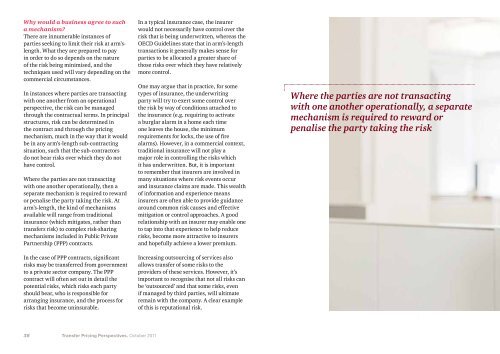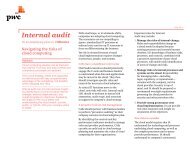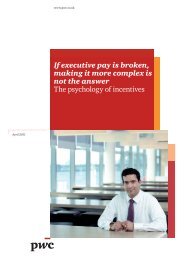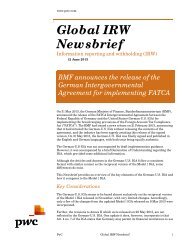Transfer pricing perspectives: Winds of Change - PwC
Transfer pricing perspectives: Winds of Change - PwC
Transfer pricing perspectives: Winds of Change - PwC
You also want an ePaper? Increase the reach of your titles
YUMPU automatically turns print PDFs into web optimized ePapers that Google loves.
Why would a business agree to sucha mechanism?There are innumerable instances <strong>of</strong>parties seeking to limit their risk at arm’slength.What they are prepared to payin order to do so depends on the nature<strong>of</strong> the risk being minimised, and thetechniques used will vary depending on thecommercial circumstances.In instances where parties are transactingwith one another from an operationalperspective, the risk can be managedthrough the contractual terms. In principalstructures, risk can be determined inthe contract and through the <strong>pricing</strong>mechanism, much in the way that it wouldbe in any arm’s-length sub‐contractingsituation, such that the sub‐contractorsdo not bear risks over which they do nothave control.Where the parties are not transactingwith one another operationally, then aseparate mechanism is required to rewardor penalise the party taking the risk. Atarm’s-length, the kind <strong>of</strong> mechanismsavailable will range from traditionalinsurance (which mitigates, rather thantransfers risk) to complex risk-sharingmechanisms included in Public PrivatePartnership (PPP) contracts.In the case <strong>of</strong> PPP contracts, significantrisks may be transferred from governmentto a private sector company. The PPPcontract will <strong>of</strong>ten set out in detail thepotential risks, which risks each partyshould bear, who is responsible forarranging insurance, and the process forrisks that become uninsurable.In a typical insurance case, the insurerwould not necessarily have control over therisk that is being underwritten, whereas theOECD Guidelines state that in arm’s-lengthtransactions it generally makes sense forparties to be allocated a greater share <strong>of</strong>those risks over which they have relativelymore control.One may argue that in practice, for sometypes <strong>of</strong> insurance, the underwritingparty will try to exert some control overthe risk by way <strong>of</strong> conditions attached tothe insurance (e.g. requiring to activatea burglar alarm in a home each timeone leaves the house, the minimumrequirements for locks, the use <strong>of</strong> firealarms). However, in a commercial context,traditional insurance will not play amajor role in controlling the risks whichit has underwritten. But, it is importantto remember that insurers are involved inmany situations where risk events occurand insurance claims are made. This wealth<strong>of</strong> information and experience meansinsurers are <strong>of</strong>ten able to provide guidancearound common risk causes and effectivemitigation or control approaches. A goodrelationship with an insurer may enable oneto tap into that experience to help reducerisks, become more attractive to insurersand hopefully achieve a lower premium.Increasing outsourcing <strong>of</strong> services alsoallows transfer <strong>of</strong> some risks to theproviders <strong>of</strong> these services. However, it’simportant to recognise that not all risks canbe ‘outsourced’ and that some risks, evenif managed by third parties, will ultimateremain with the company. A clear example<strong>of</strong> this is reputational risk.Where the parties are not transactingwith one another operationally, a separatemechanism is required to reward orpenalise the party taking the risk38 <strong>Transfer</strong> Pricing Perspectives. October 2011
















